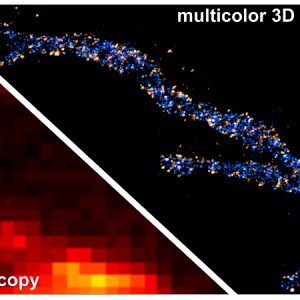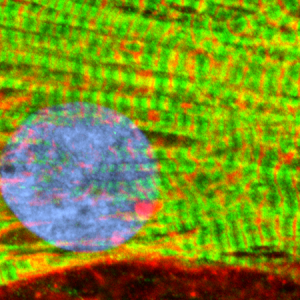14.08.2020
Authors Dijkman PM, Muñoz-García JC, Lavington SR, Kumagai PS, Dos Reis RI, Yin D, Stansfeld PJ, Costa-Filho AJ, Watts A Journal Science Advances Citation Sci Adv. 2020 Aug 14;6(33):eaav8207. Abstract G protein-coupled receptors (GPCRs) are the largest and pharmaceutically most important class of membrane proteins encoded in the human genome,
11.08.2020
Multicolor 3D MINFLUX nanoscopy of mitochondrial MICOS proteins
Authors Pape JK, Stephan T, Balzarotti F, Büchner R, Lange F, Riedel D, Jakobs S, Hell SW Journal Proceedings of the National Academy of Sciences Citation PNAS, Aug 2020, 202009364. Abstract The mitochondrial contact site and cristae organizing system (MICOS) is a multisubunit protein complex that is essential for the
11.08.2020
Proteine ganz nah
In einer ersten Anwendung der leistungsstarken MINFLUX-Nanoskopietechnik in der Zellbiologie haben Forscher um Stefan Hell und Stefan Jakobs die Verteilung einzelner Proteine in einem etwa 20 Nanometer großen Proteinkomplex innerhalb eines Zellorganells mehrfarbig und dreidimensional sichtbar gemacht. Diese Technik ist damit hundertmal schärfer als die herkömmliche Fluoreszenz-Lichtmikroskopie. Die MINFLUX-Nanoskopie erweist
10.08.2020
The Role of Alpha-Synuclein and Other Parkinson’s Genes in Neurodevelopmental and Neurodegenerative Disorders
Authors Morato Torres CA, Wassouf Z, Zafar F, Sastre D, Outeiro TF, Schüle B Journal International Journal of Molecular Sciences Citation Int. J. Mol. Sci. 2020, 21(16), 5724. Abstract Neurodevelopmental and late-onset neurodegenerative disorders present as separateentities that are clinically and neuropathologically quite distinct. However, recent evidence hashighlighted surprising commonalities
10.08.2020
Reliable estimation of membrane curvature for cryo-electron tomography
Authors Salfer M, Collado JF, Baumeister W, Fernández-Busnadiego R, Martínez-Sánchez A Journal PLoS Computational Biology Citation PLoS Comput Biol. 2020 Aug 10;16(8):e1007962. Online ahead of print. Abstract Curvature is a fundamental morphological descriptor of cellular membranes. Cryo-electron tomography (cryo-ET) is particularly well-suited to visualize and analyze membrane morphology in a
06.08.2020
RAB39B is redistributed in dementia with Lewy bodies and is sequestered within aβ plaques and Lewy bodies
Authors Koss DJ, Bondarevaite O, Adams S, Leite M, Giorgini F, Attems J, Outeiro TF Journal Brain Pathology Citation Brain Pathol. 2020;10.1111/bpa.12890. Abstract Loss of function mutations within the vesicular trafficking protein Ras analogy in brain 39B (RAB39B) are associated with rare X‐linked Parkinson’s disease (PD). Physiologically, RAB39B is localized
05.08.2020
CRISPR/Cas9 – GENE EDITING: Neuer Therapieansatz für angeborene Herzfehler
Wissenschaftler am Herzzentrum der Universitätsmedizin Göttingen haben erstmals einen Ansatz für eine personalisierte Therapieoption mit „Gene Editing“ für das Noonan-Syndrom gefunden. Veröffentlicht in der renommierten Fachzeitschrift „Circulation„. Link zur Pressemitteilung des DZHK
05.08.2020
CRISPR/Cas9 – GENE EDITING: New therapeutic approach for congenital heart defects
Scientists at the Heart Center of the University Medical Center Göttingen have for the first time found an approach for a personalised therapy option with „gene editing“ for the Noonan Syndrome. Publication in the renowned journal „Circulation„. (umg/ mbexc) Congenital heart diseases are the most common organ defects. They occur
01.08.2020
Remyelination in multiple sclerosis: from basic science to clinical translation
Authors Lubetzki C, Zalc B, Williams A, Stadelmann C, Stankoff B Journal The Lancet. Neurology Citation The Lancet. Neurology. 2020 Aug;19(8):678-688. Abstract The treatment of multiple sclerosis has been transformed by the successful development of immunotherapies that efficiently reduce disease activity and related clinical relapses during the relapsing-remitting phase of




